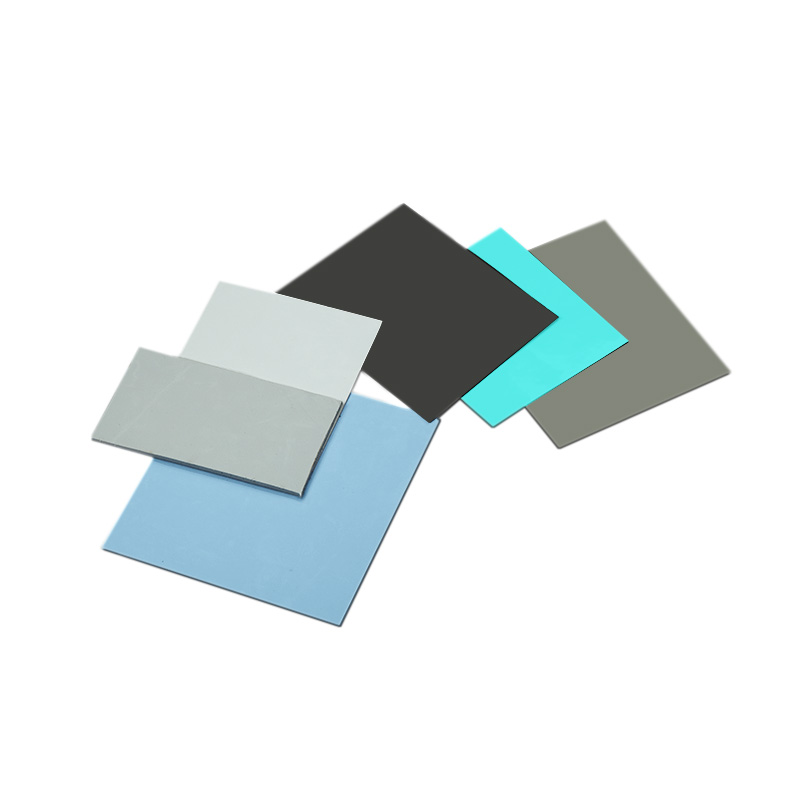Cell phone:13600151511 (Manager Gao)
Cell phone:15813720327(Director Chen)
Phone:+86 0755 29832951
Office Address:East of 201, No. 20-5, Jixiang 1st Road, Pingxi Community, Pingdi Street, Longgang District, Shenzhen
Factory Address:No.2,Fudong 4th Road,Dong'ao Village,Shatian Town,Huiyang District,Huizhou City,Guangdong Province,China
Thermally conductive silicone film is a kind of thermally conductive medium material synthesized by a special process with silicone as the base material and adding various auxiliary materials such as metal oxides, in the industry, also known as thermally conductive silicone pad, thermally conductive silicone film, soft thermally conductive pad, thermally conductive silicone gasket, etc. It is specially produced for the design scheme of heat transfer using gaps, which can fill the gaps and complete the heat transfer between the heat generating part and the heat dissipating part, and also play the role of insulation, shock absorption, sealing, etc. It can meet the design requirements of equipment miniaturization and ultra-thin, and is an excellent thermally conductive filling material with great processability and usability, and a wide range of thickness.

The following three methods of thermal conductivity testing are commonly used for thermally conductive silicone films.
1. Hot Plate method (Hot Plate)/Heat Flow Meter method (Heat Flow Meter) steady state method
The principle is the Fourier heat transfer equation calculation method: dQ=-λdA-dt/dn
Where: Q----- heat conduction rate, w;
A----- heat conduction area, m2;
dt/dn----- temperature gradient, K/m;
λ------ thermal conductivity, w/m-K;
The thermal conductivity of the sample is obtained by applying a certain heat flow rate to the sample during the test, testing the thickness of the sample and the temperature difference between the hot plate/cold plate, and the test process requires the sample to be a large block of conventional shape to obtain sufficient temperature difference. Source of error: The sample in the hot/cold plate is not well protected and there is some heat loss. The temperature measurement element is a thermocouple, and the interfacial influence of the hot plate/cold plate gap is taken into account. The first source of error makes this method unsuitable for samples with thermal conductivity > 2 W/mK, the heat loss is too large and the higher the temperature, the larger the error. The second source of error actually includes the contact thermal resistance, and the temperature difference is large, so the actual measured thermal conductivity is low. In addition, this method can only provide the data of thermal conductivity with an accuracy of 5%.
2. Laser Flash method
The transient method, which is based on the principle that a laser beam hits the upper surface of the sample, and the temperature change of the lower surface is measured with an infrared detector. The actual measured data is the thermal diffusivity of the sample, and the density and specific heat of the sample are obtained simultaneously by comparing with the standard sample through Cp=λ/H, H---- thermal diffusion coefficient, m2/s; λ---- thermal conductivity, w/m-K; Cp---- volume specific heat, J/ m3-K, and the thermal conductivity of the sample is calculated from the data. The advantage of this test method is that it is fast, non-contact method, suitable for high temperature, high thermal conductivity samples, but not suitable for multilayer structures, coatings, foams, liquids, anisotropic materials, etc. The reason is that the laser method tests the thermal diffusivity, and the mathematical model is based on isotropic materials. If it is a multilayer structure, coating, or if there is absorption/radiation of the sample, the specific heat of the measured sample appears to deviate significantly. In addition, the density needs to be measured by other methods in order to convert to thermal conductivity, increasing the source of error. Usually, the accuracy of laser pulse method is 3% for thermal diffusivity, 7% for specific heat, and 10% for thermal conductivity.
3、Hot Disk (TPS technique)
Sample size: solid: diameter or edge length greater than 2mm, thickness greater than 0.5mm (2 identical), sample can be irregularly shaped, as long as the upper and lower surfaces are flat; thermal conductivity range: 0.005-500 W/mK. Temperature range: room temperature - 700°C, test principle: Transient Planar Heat Source (TPS) technology, test modules: basic, thin film, flat plate, anisotropic, single-sided, specific heat. Probe size: 2-29.40 mm .
Ltd. is a professional manufacturer and sales of various thermal conductivity silicone and wiring equipment. The company's product specifications are complete, mainly a variety of high-quality thermal conductive silicone film, thermal conductive silicone grease, thermal conductive graphite sheet, thermal conductive double-sided adhesive, thermal conductive potting adhesive, anti-static silicone film, silicone, rubber foot pad, LED spacer column, PC board parts, fixed seat, protection parts, terminals, connectors and other products; its products are widely used in electronic computers, automation equipment and communications, household appliances and so on.

- Website Home - About Us
- News - Product Show
- Honors and Qualifications - Production strength
- Case Studies - Online Message
- Contact Us
Contact Method:13600151511
Mailbox:gaowenjie@keshihua.com
Office Address:East of 201, No. 20-5, Jixiang 1st Road, Pingxi Community, Pingdi Street, Longgang District, Shenzhen
Factory Address:No.2 Fudong 4 Road, Dong'ao Village, Shatian Town, Huiyang District, Huizhou City, Guangdong Province

Follow us
